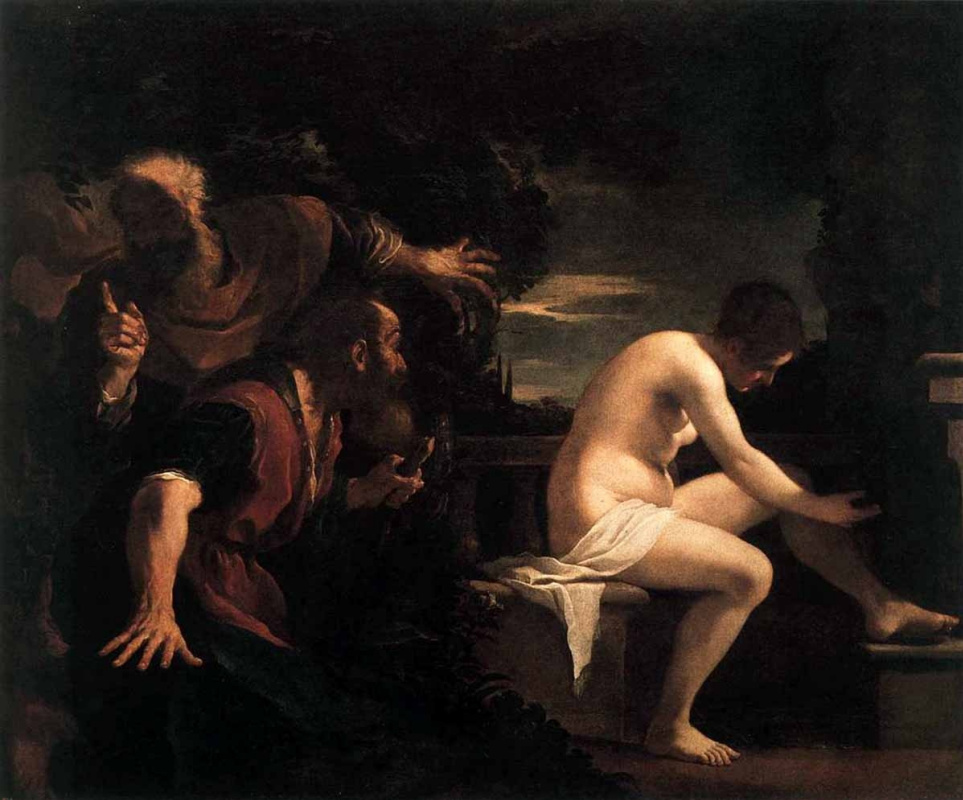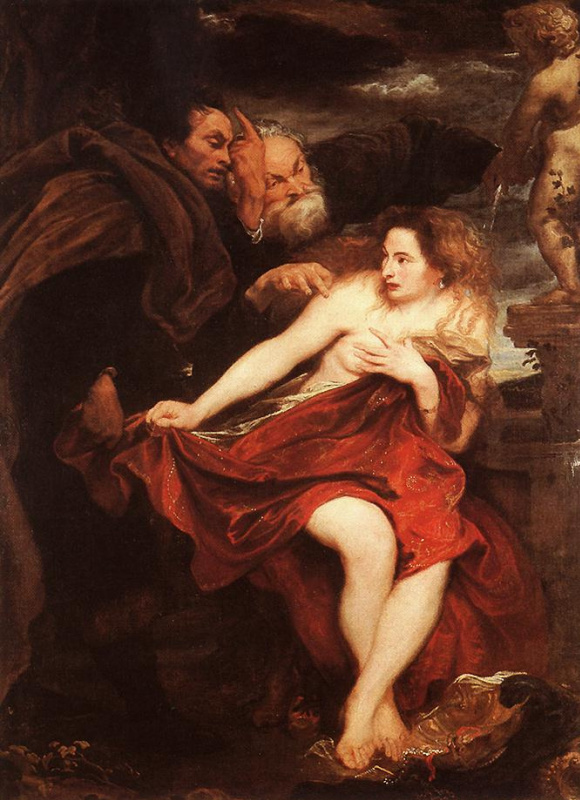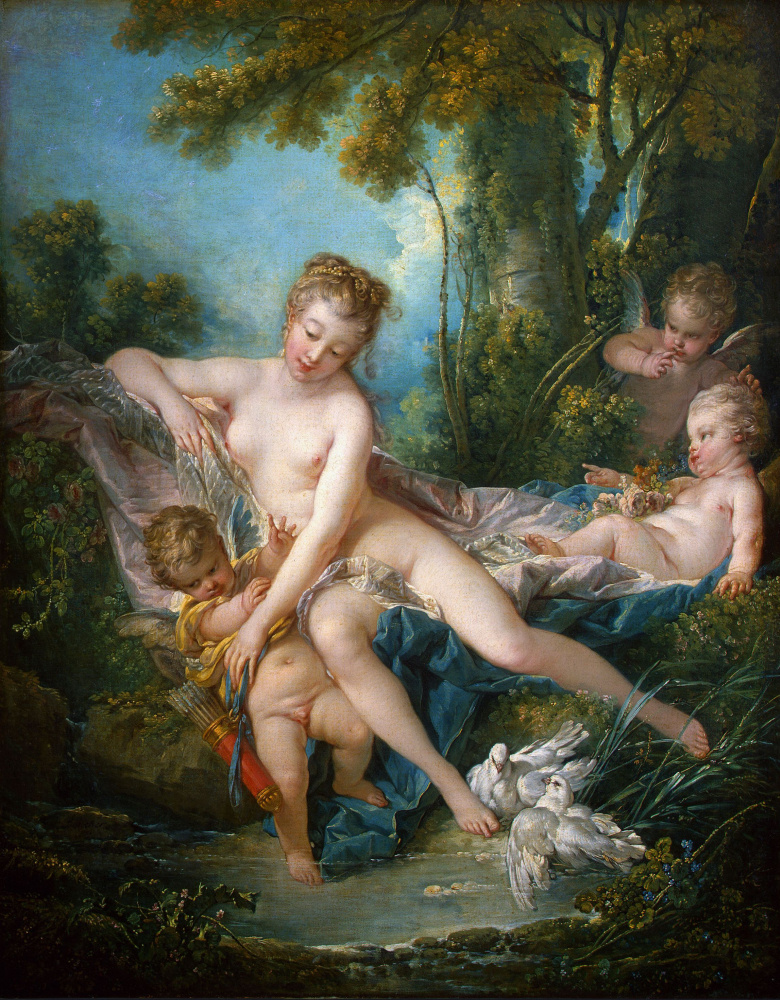Films by the brilliant Master of Suspense have been heating the imagination of thriller fans for several decades. According to the majority of movie lovers, any modern horror film, full of blood and ghosts suddenly pouncing upon their victims, cannot be compared with movie masterpieces of Alfred Hitchcock. The producer masterfully creates the oppressive and exhausting atmosphere of a quiet nightmare. Many details and subtleties in Hitchcock’s films are of particular importance. The attentive audience have noticed art works occasionally appearing in the frames of his masterpiece "Psycho" (1960). What are these pictures? What do they symbolize in the film? Ultimately, what is the role of painting in the work of Hitchcock?

The brief plot summary, in case you should forget it
The story begins in Phoenix, Arizona. Secretary Marion Crane has stolen 40 thousand dollars from her boss and escapes from the city. She stops for the night in a secluded Bates Motel. The proprietor of the gloomy hotel is a charming young man named Norman Bates, who has rather strange and unhealthy relationship with his mother. Norman has taken a liking to his guest, but his mother strongly opposes him. And then Marion decides to take a shower, and it becomes her fatal mistake.In case you have not seen the "Psycho" yet and are just going to watch it, we will stop here. Especially as the targeted paintings are shown in the first part of the film.

A screen capture from the "Psycho" movie.
The painting and a hole in the wall
When Marion comes to Bates Motel, Norman invites her to a light dinner in the living room. The wall behind the young man is decorated with stuffed birds and two paintings. Later, when Marion goes to her room, Norman takes one of the canvases off the wall and spies on the changing girl through a hole in the wall. Let us dwell upon this picture in detail.The most attentive researchers of Hitchcock’s work have determined that the picture hiding the hole is the painting by the Dutch painter Frans van Mieris, the Elder "Susanna and the Elders" painted in the 17th century. It depicts a popular story from the Old Testament Book of Daniel.

A screen capture from the "Psycho" movie.
The story tells about a young lovely Hebrew wife Susanna from Babylon who bathed naked in her garden, unaware about two old men secretly observing her. They were the respected elders and judges who "were both wounded with the love of her". When the woman finished bathing, the elders accosted her and threatened to claim that she was caught in adultery in the garden unless she agrees to have sex with them. Susanna realizes that she would be put to death for such an accusation and still refuses the men, so they fulfill their threats. The woman is sentenced to death, but at the last moment she is saved by the prophet Daniel who shouts that the elders should be questioned separately and convicts them of lying. Thanks to the intervention of the prophet Susanna remains alive, and the false accusers are put to death.
The subject of this picture is very symbolic in the context of the movie. Norman Bates peeks Marion through the hole in the wall hidden behind the picture, just like the elders peeked Susanna. He is also "wounded with the love", but he has to suppress his feelings for the sake of his despotic mother. The shower scene is the culmination of the growing sense of the threat of violence, common for the picture and the movie.
The subject of this picture is very symbolic in the context of the movie. Norman Bates peeks Marion through the hole in the wall hidden behind the picture, just like the elders peeked Susanna. He is also "wounded with the love", but he has to suppress his feelings for the sake of his despotic mother. The shower scene is the culmination of the growing sense of the threat of violence, common for the picture and the movie.

The story of Susanna, who was unjustly accused and happily saved, was a rather popular story in painting since Late Renaissance. More often than not, the artists portrayed Susanna either bathing (with the elder men in the background) or defending herself against the harassment of lascivious elders. Frans van Mieris has several works depicting this story, and the canvas, captured in the film, is not the most popular of them. It is stored in the Museum of Hyacinth Rigo in Perpignan, France. There are no color reproductions of it in the Internet, as if it is a mark of respect for the black and white "Psycho".
And here is how other famous painters portrayed Susanna and the villainous elders:
And what about the second painting?
The canvas hanging next to "Susanna and the Elders" is much easier to identify. This is a reproduction of the famous "Venus with a Mirror" by Titian. The painting was one of the artist’s favorite works, and he adamantly refused to sell it. There are many replicas of the "Venus", painted both by Titian himself and his studio.After the death of the artist, the painting was in the possession of a Venetian patrician Cristoforo Barbarigo. It remained in his family palazzo for almost three hundred years. In 1850, Nicholas I of Russia bought the collection of the last member of the Barbarigos, thus the canvas moved to the Hermitage. However, it was not the end of the journey of the "Venus with a Mirror". In 1929, the government of the USSR decided to sell some of the Hermitage paintings, that was how this canvas and some other Titian’s paintings became part of the collection of Secretary of the US Treasury Andrew Mellon. After his death, the collection came into national possession. It became the basis for the collection of the National Gallery of Art in Washington.
Venus with a mirror
1555, 124.5×105.5 cm
But back to the movie. Film experts believe that Hitchcock’s choice of the painting by Titan was also quite purposive. "Venus in front of a mirror" and "Susanna and the Elders" are both symbols of the suppressed sexuality of Norman Bates, forcing him to surround himself with images of half-naked women because of the inability to make a real relationship.
Some more pictures are seen in the room of Norman Bates. However, they appear for a very short time or are hidden in the shadow or out of focus. Therefore, they are rather difficult to identify. So far, only the painting "Venus Consoling Love" by François Boucher has been identified. Thus, the "Psycho" movie is fraught with many more mysteries.
Venus consoling Love
1751, 84×107 cm
What`s it got to do with Edward Hopper apparently?
The paintings of the American artist Edward Hopper are directly related to the "Psycho" movie. Look at the famous sinister building of Bates Motel. It was built specifically for the film and became its most expensive scenery. And the idea of the house was inspired by the lonely empty structure half hidden in the shade at Hopper’s painting "The House by the Railroad".However, the canvas that inspired Hitchcock to build a gloomy mansion, which hides madness under its roof, was not the only work of Hopper, which influenced the aesthetics of the movie. They called the artist "the poet of empty spaces". He was famous for his ability to create a depressing atmosphere on the canvas, depicting just the daily reality. Many frames of the "Psycho" movie refer to the pictures by Hopper.
In his interview about the film production, the scriptwriter Joseph Stefano said, "I told Anthony Perkins (playing Norman — Ed.) that if Norman Bates was a picture, it would be painted by Edward Hopper; and he agreed with me."
In his interview about the film production, the scriptwriter Joseph Stefano said, "I told Anthony Perkins (playing Norman — Ed.) that if Norman Bates was a picture, it would be painted by Edward Hopper; and he agreed with me."
In many of his works, Hopper forces the viewer to become a voyeur, just as Hitchcock does in the scene with the picture and the hole in the wall. However, the artist often peeps at lives of other people through windows. In both cases, the viewer seems to become an involuntary accomplice in an impropriety, but he is unable to deny himself this forbidden pleasure.
The culmination of the morbid curiosity to unite the works of Hitchcock and Hopper was the "Rear Window" movie (1954), based on "It had to be a murder" story by Cornell Woolrich. The aesthetics of Hopper paintings pervades its every frame
.
Most of the "peeping" works were made by the artist in New York about New York. The action of the "Rear Window" movie takes place here as well. This film, just as the paintings by Hopper, is not much about voyeurism, rather about isolation and "loneliness in a big city". Every day, thousands of small stories take place here, enclosed in frames of windows and brick walls.
The pictures by Edward Hopper are also referred in "Twin Peaks" by David Lynch. See the article "Claude Monet, Gustav Klimt and 5 other artists who influenced the 'Twin Peaks' by David Lynch" on Arthive.
Even Dali has to do with it
But Hopper was not alone. In 1945, Hitchcock addressed Salvador Dali with a proposal for cooperation. He wanted the artist to take part in the production of a surreal episode in the "Spellbound" movie starring Ingrid Bergman and Gregory Peck. It was the scene of a nightmarish sleep of the Peck’s amnesic character; his woman, a psychiatrist, tries to figure out his role in a mysterious murder. Therefore, Hitchcock decided that he needed Dali for the nightmare to be more accute.The Hollywood tradition of the time held that dreams were rather obscure and fuzzy. The director did not accept this approach. After many years, Hitchcock gave an interview about the work on the film, "I wanted to depict a dream of great visual clarity — even sharper than the film itself. I invited Dali, because his works were architecturally clear. Well, De Chirico had the same qualities, like long shadows, infinite distances, convergence of lines and perspective. Nevertheless, Dali had some strange ideas. He wanted a statue, decaying into pieces like a shell, and ants creeping over it. Moreover, Ingrid Bergman covered with ants was supposed to be inside! It was really impossible."

A screen capture from the "Spellbound" movie.
Hitchcock rejected other insane ideas of the artist as well. For example, a scene with a ballroom and fifteen grand pianos suspended over the heads of the dancers. Other frames were trimmed from the dream episode during the editing. As a result, the 20-minute material turned into short three minutes of screen time.
After the "Spellbound" was released, it has received many enthusiastic reviews. However, now this film is rarely mentioned among the best works of Hitchcock. As for Dali, he almost never talked much about this work, which was completely untypical for him. Probably, it was caused by his disappointment. Only once the artist dropped that the best scenes from the dream episode were trimmed.
After the "Spellbound" was released, it has received many enthusiastic reviews. However, now this film is rarely mentioned among the best works of Hitchcock. As for Dali, he almost never talked much about this work, which was completely untypical for him. Probably, it was caused by his disappointment. Only once the artist dropped that the best scenes from the dream episode were trimmed.
ArtHive will answer your most intricate questions under the heading "Let`s figure it out".
You can propose the ideas in the comments to this material or send an e-mail: editor@arthive.com
You can propose the ideas in the comments to this material or send an e-mail: editor@arthive.com
Arthive: follow us on Instagram






























